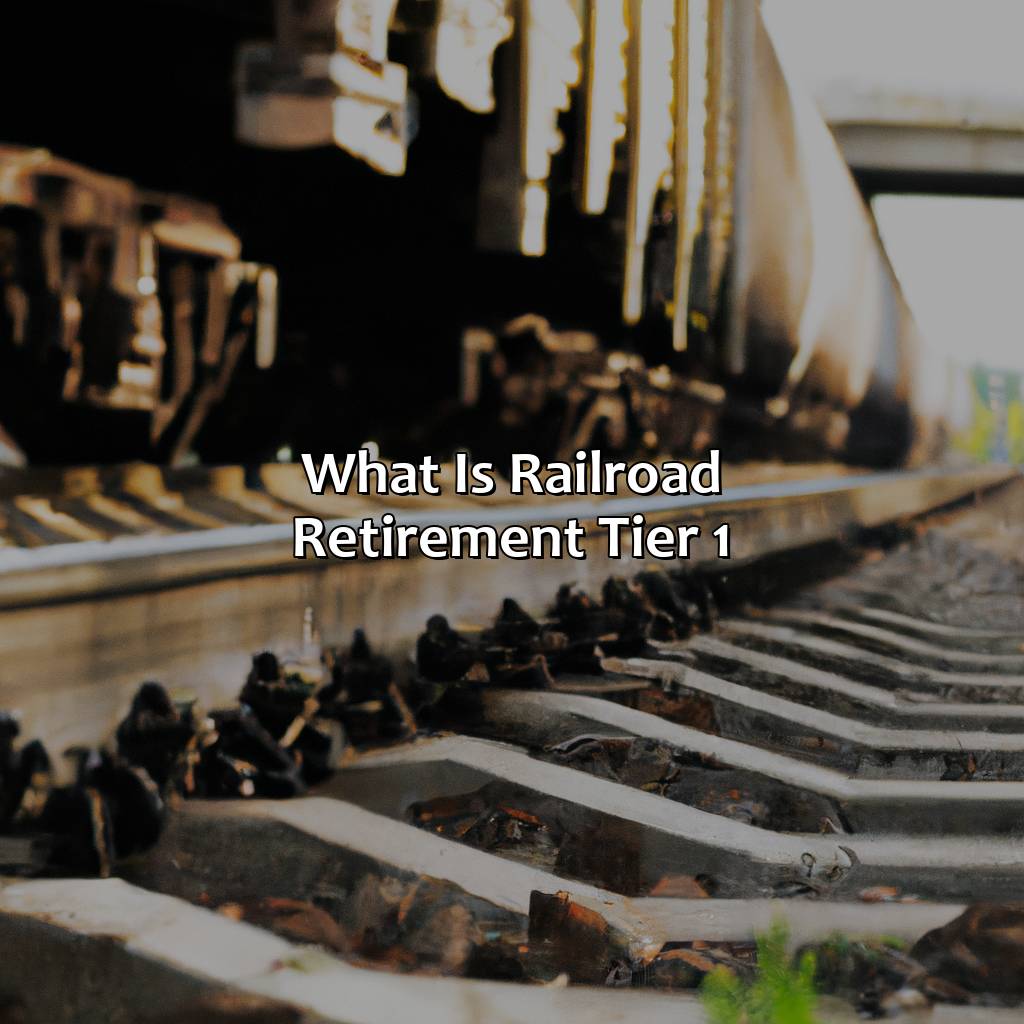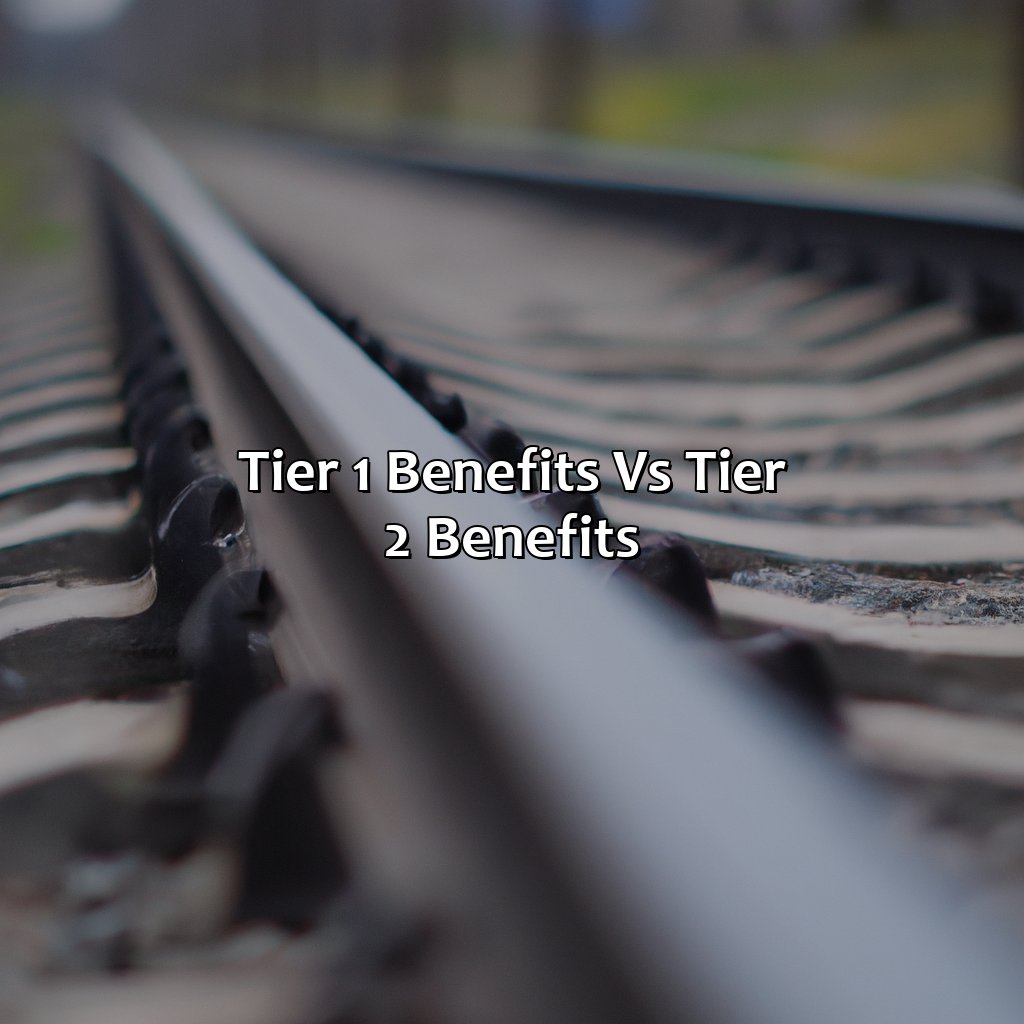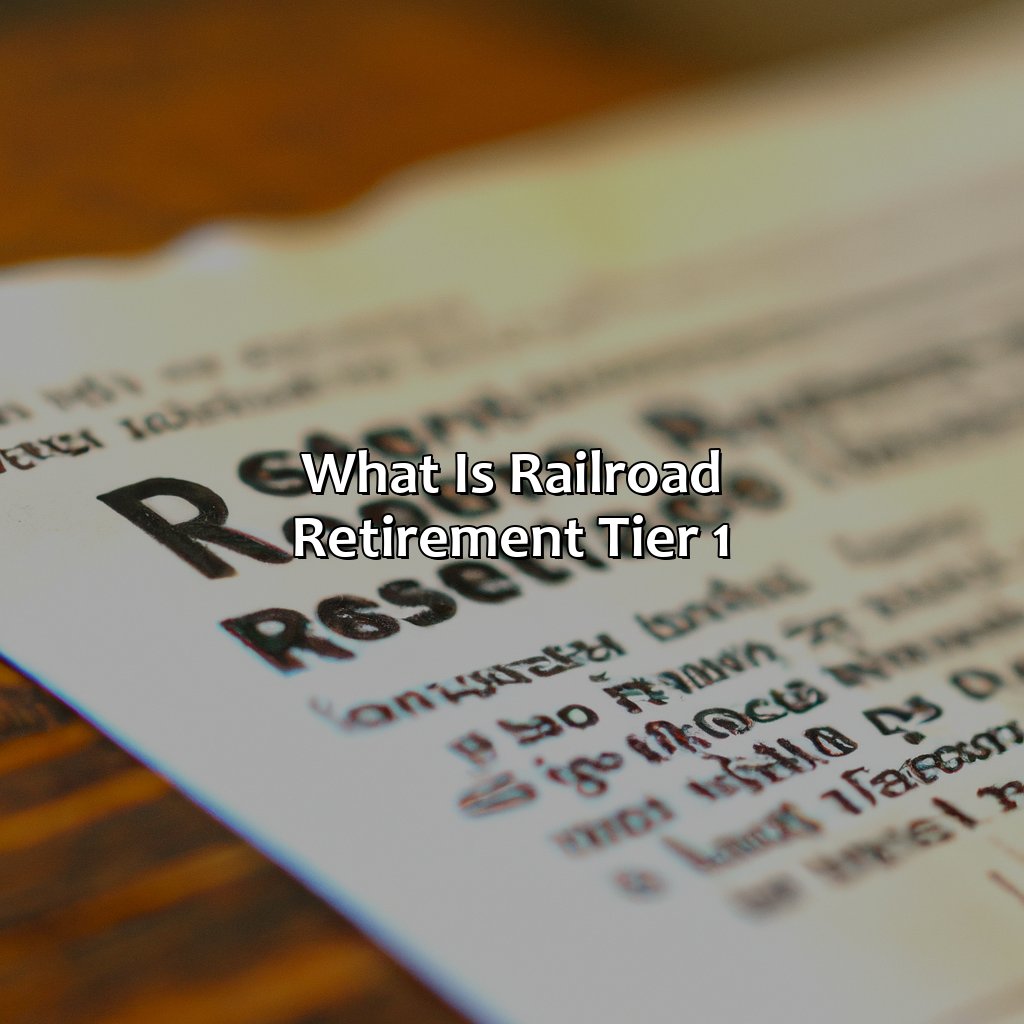What Is Railroad Retirement Tier 1?
Key Takeaway:
- Railroad Retirement Tier 1 is a federal program that provides retirement, survivor, and disability benefits to eligible railroad workers and their families.
- Tier 1 benefits are calculated based on an employee’s Average Indexed Monthly Earnings (AIME) and the number of years of railroad service. Eligible workers must have 360 months of credited service to receive Tier 1 benefits.
- Tier 1 benefits are different from Tier 2 benefits, which provide additional retirement benefits to eligible railroad employees and their families. Tier 2 benefits are calculated based on a different formula and require separate eligibility requirements.
Do you want to know more about Railroad Retirement Tier 1? Look no further! This article provides an in-depth overview of this essential retirement benefit, allowing you to make informed decisions about your financial future.
What is Railroad Retirement Tier 1?
What is Railroad Retirement Tier 1? Let’s explore! We’ll look at its definition, eligibility, and how benefits are calculated. To find out if this government retirement program can benefit you, check out the sub-sections on each aspect. See if you qualify and how much you’d get in benefits!

Image credits: retiregenz.com by David Woodhock
Definition of Tier 1
Railroad Retirement Tier 1 is the first part of a two-part benefits system for retired railroad employees that is similar to Social Security. It provides basic retirement and survivor benefits based on an employee’s years of service and earnings history in the railroad industry. The Tier 1 benefit formula is designed to be comparable to Social Security, but it uses a different calculation method and has some different rules regarding eligibility and benefit amounts.
To qualify for Tier 1 benefits, a retiree must have worked in the railroad industry for at least five years. Their monthly benefit amount is calculated based on their average indexed monthly earnings (AIME) during their highest-earning 35 years of work, adjusted for inflation, up to a certain maximum amount. The actual benefit paid may also be affected by factors such as age at retirement, marital status, and whether other family members are eligible for benefits.
One interesting aspect of Railroad Retirement Tier 1 is that it was created in response to labor strikes by railroad workers in the early 20th century. These strikes disrupted transportation across the country and led to significant economic losses. The government eventually agreed to establish a pension system for railroad workers as a way to prevent future strikes and maintain stability in the industry.
Today, Railroad Retirement Tier 1 continues to provide important retirement security for thousands of retired railroad employees and their families. You don’t need to have a career in railroads, just a love for trains and a desire for retirement benefits to be eligible for Tier 1.
Eligibility for Tier 1 Benefits
To qualify for Railroad Retirement Tier 1 benefits, individuals must meet certain criteria. These benefits are available to retired railroaders who have worked for the railroad industry long enough to earn their credits. Here are some eligibility requirements:
- Must be age 62 or older
- Must have at least ten years of service in the railroad industry, or five years after Dec. 31, 1995
- Must have completed 30 years of service in the railroad industry, regardless of age
- Must meet certain disabilities standards if under age 62
- Surviving spouses and children may also be eligible for benefits
Additionally, it’s important to note that Tier 1 benefits are based on an individual’s average monthly earnings during their highest paying years in the railroad industry. This information is used to calculate the monthly benefit amount.
It’s interesting to know that Railroad Retirement Tier 1 benefits were established in the early 20th century to provide retirement and survivor benefits specifically to those working in the railroad industry. Today, over one million people receive these benefits each year.
Why do math teachers love Railroad Retirement Tier 1? Because they can calculate benefits while conducting their own train of thought.
How Tier 1 Benefits are Calculated
Tier 1 Benefits Calculation is initiated by calculating credits and applying a formula that takes into account the credits earned by the beneficiary. The calculation of tier 1 benefits is based on years of credited railroad service, not taking into account any non-railroad earnings.
Below is an example table indicating how Tier 1 Benefits are Calculated:
| Years of Credited Service | Credits Earned |
|---|---|
| Less than 10 years | Credits multiplied by $49.50 |
| 10 or more years but less than 20 years | Multiply credits by $176.00 and add $495 |
| 20 or more years but less than 30 years | Multiply credits by $220.00 and add $1560 |
| 30 or more years | Multiply credits by $253.00 and add $2790 |
To get a clear idea about one’s own tier one benefits, beneficiaries may use the RRB’s ‘Benefit Calculator’ to calculate their benefits with ease.
It’s crucial to ensure that all claimed work and service history have been properly credited for accurate calculations of Tier 1 Benefits.
Did you know? – According to the Railroad Retirement Board, retirements in the first quarter of 2021 saw over three-quarters of those retiring from railroad employment being eligible to receive some type of reduced annuity at age 60 after completing at least five years of service.
Tier 1 benefits are like first class seats on a luxury train, while Tier 2 benefits feel more like riding in the caboose.
Tier 1 Benefits vs. Tier 2 Benefits
Want to know the contrast between Railroad Retirement Tier 1 and Tier 2 benefits? Here’s the scoop: Tier 2 definition and the differences between Tier 1 and Tier 2 benefits. Let’s go!

Image credits: retiregenz.com by Joel Duncun
Definition of Tier 2
Tier 2 benefits are a supplemental income for railroad retirement employees. These benefits are paid to those who have more than ten years of service with the railroad industry but do not qualify for tier 1 benefits. Unlike tier 1, these benefits are not guaranteed and can vary based on an employee’s compensation and age at the time of retirement.
To qualify for tier 2 benefits, the minimum requirements are ten years of service in the railroad industry, at least five years of which must be after 1995. Additionally, there is an age requirement; individuals must be at least 60 years old or have at least thirty years of service to qualify.
It’s important to note that tier 2 benefits may also be reduced or eliminated if an individual receives Social Security benefits. This is because part of the Tier II benefit formula is linked to the Social Security maximum family benefit formula.
One railway worker shared his experience with tiers one and two benefits. He had worked in the industry for over twenty-five years and qualified for both tiers one and two. However, he found that his tier 2 benefit was significantly lower due to his high compensation throughout his career, which increased his average monthly earnings used to calculate his benefit amount.
Tier 1 and Tier 2 benefits may sound like a sound system, but they’re nothing like a good pair of speakers for your retirement.
Differences between Tier 1 and Tier 2 Benefits
Railroad Retirement Tier 1 and Tier 2 Benefits have significant differences. The former is considered a basic retirement scheme, while the latter is supplemental. Here are some key differences between them:
| Railroad Retirement Tier 1 | Railroad Retirement Tier 2 | |
|---|---|---|
| Qualification requirements | Minimum of 10 years of service | Completing service regulations as stipulated by Railroad Retirement Board |
| Method of calculation of benefits | Based on Average Indexed Monthly Earnings (AIME) | Based on Years credited in service |
| Benefit Amount Limits | Subject to Social Security Benefit Offsets | No Social Security Benefit Offsets |
Another important feature that differs between these two schemes is that the retirement age varies. While employees may begin receiving benefits from the former at 62 years old under normal conditions, no such guarantee exists for the latter.
It’s worth noting that Railroad Retirement was established in response to widespread labour disruptions and train stoppage in America during 1937. It provides comprehensive tax-free retirement income plans for railroad workers and their dependents.
Five Facts About Railroad Retirement Tier 1:
- ✅ Railroad Retirement Tier 1 is a part of the US federal retirement program that provides benefits to railroad workers based on their years of service and age at retirement. (Source: Railroad Retirement Board)
- ✅ Tier 1 benefits are calculated using a formula that takes into account the worker’s years of service and average earnings in the railroad industry. (Source: Investopedia)
- ✅ Railroad workers are eligible for Tier 1 benefits once they reach age 62 and have completed at least 10 years of service. (Source: AARP)
- ✅ The amount of Tier 1 benefits is calculated based on a worker’s “creditable compensation” earned during their career. (Source: SmartAsset)
- ✅ Railroad Retirement Tier 1 benefits are subject to federal income tax, and some states may also tax them. (Source: The Balance)
FAQs about What Is Railroad Retirement Tier 1?
What is Railroad Retirement Tier 1?
Railroad Retirement Tier 1 refers to the basic retirement benefit that railroad employees are entitled to receive. It is similar to the Social Security retirement benefit for non-railroad workers.
How is Railroad Retirement Tier 1 calculated?
The Railroad Retirement Tier 1 benefit is calculated based on the employee’s average monthly earnings during their highest 35 years of railroad service. It is then adjusted for inflation before being paid out.
Can you receive Railroad Retirement Tier 1 and Social Security benefits?
Yes, if you have worked both in the railroad industry and in jobs covered by Social Security, you may be eligible for both Railroad Retirement Tier 1 and Social Security benefits. However, there are some differences in how the benefits are calculated and paid out.
Is Railroad Retirement Tier 1 the only retirement benefit available to railroad employees?
No, railroad employees are also entitled to receive an additional benefit called Railroad Retirement Tier 2, as well as a supplemental annuity for those who retire early.
When can I start receiving Railroad Retirement Tier 1 benefits?
You can start receiving Railroad Retirement Tier 1 benefits as early as age 62, or as early as age 60 if you have at least 30 years of railroad service. You can also choose to delay receiving benefits until as late as age 70 to receive a higher monthly benefit.
What happens to Railroad Retirement Tier 1 benefits when the employee passes away?
If the railroad employee passes away, their Railroad Retirement Tier 1 benefits may be paid to their surviving spouse or dependent children. The amount paid varies based on the employee’s earnings and their family’s situation.



